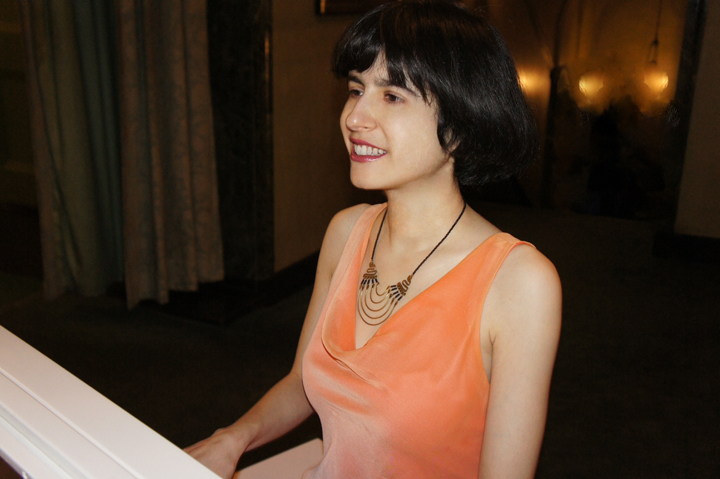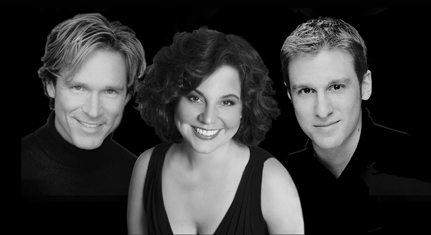In a series entitled “Here and Now,” pianist Nataliya Medvedovskaya offered a unique smorgasbord of modern works in the equally unique venue, Bargemusic. The “Here” is New York, the base of 10 composers on her program including herself (the exception being Jeremy Beck from Kentucky), and the “Now” stretched from the present to as far back as 1976, the date of Lowell Liebermann’s Piano Sonata, No. 1. The program notes state that Ms. Medvedovskaya researched several hundred compositions before choosing her program based on “fresh compositional ideas, arresting tonal values, and colorful, interesting harmonies.” While not all of these criteria came to mind equally with each piece, it was clear that the pianist herself felt complete commitment to each one, playing all with thoughtful involvement, projection, and polish. Each work was memorized, which is no small feat in newer piano literature and an unusual testament to the performer’s dedication. Many of the composers were present and expressed deep gratitude for this pianist’s performances, and listeners were grateful for a sampling of largely unfamiliar fare played with excellence.
With a change to the printed program, the opening work was Eugene McBride’s Nocturne, a modern, somewhat Scriabinesque version of the genre of Chopin and Field, with some intense development in its central section. It invited the listener inside, as befits an opener. Eugene Marlowe’s 3 pieces from “Les Sentiments D’Amour” followed: “Rougir Pour la Première Fois” (First Blush) “Melancolie” (Melancholy), and “Le Charmeur” (The Flirt), played with polish and élan. Marlowe’s accessible, breezy style was a good foil for what came next, some compositions by the pianist herself. Ms. Medvedovskaya’s 4 pieces, Scherzo, March, Lullaby, and Burlesque, proved effective miniatures showing significant influence of Shostakovich and Kabalevsky (my listening companion suggested “Shostalevsky”). Nothing disparaging is meant, as these are interesting character pieces, simply that Ms. Medvedovskaya’s years at the legendary Rimsky-Korsakov Conservatory of St. Petersburg, Russia have had their imprint. Next came Debra Kaye’s Visions Fugitives (2 piano pieces), inspired by Ms. Kaye’s stay in Taos, New Mexico. Though the title obviously refers to Prokofiev’s Op. 22, the music, in its evocation of a noble, open landscape, seemed to bear some kinship with Copland. It brought large emotions into small forms.
The first half ended with Lowell Liebermann’s Piano Sonata, Op. 1, composed at age fifteen (1976). An auspicious start to the impressive career that ensued, this work contains more than just seeds of future greatness, as it has moments of haunting beauty (especially the third movement, Lento), along with taut craftsmanship. Ms. Medvedovskaya gave it a cogent performance, with a particularly rousing fourth movement finale.
After intermission, there were again intriguing miniatures, Binnette Lipper’s two Bagatelles (from a set of seven) of which were selected the whimsical “Dalliance” and the extraterrestrial-inspired “Spatial Relations” both given vivid characterizations in the pianist’s interpretations. A Toccata by Jeremy Beck held its head up well next to its twentieth-century predecessors in the genre by Ravel and others, and Ms. Medvedovskaya paid attention to sound and balance throughout it, never stressing the sheer perpetual motion aspect. In contrast followed Rain Worthington’s “Hourglass,” a reflection on the passage of time. Reviewer Jack Sullivan from American Record Guide described Ms. Worthington’s music well, attributing to it a “Satie-like repose.” Ms. Medvedovskaya brought out the timeless, sinuous qualities with sensitivity. “Prelude” by Beata Moon recovered the recital’s momentum with the fluidity of music inspired by dolphins, and almost “New Age” in style, though with some immediately affecting Romantic harmonies. Ms. Moon’s second piece held me less, its climactic glissandi seeming a bit facile in context.
Some good old-fashioned fun brought the program back to earth with Robert S. Cohen’s two movements from “An Ant’s World.” “The Work Never Ends” set the scene as the busy world of ants, while “Invasion of the Anteaters” married the ragtime feel of some Bolcom works with dark humor reminiscent of Gounod’s Marionettes. It was a sped-up quote from Chopin’s Funeral March, though, that made for the most outright laughter. The pianist relished every bit of the fun, as did her audience.
The program closed with the first scene from Ms. Medvedovskaya’s own ballet based on “The Wonderful Adventures of Nils,” a fairy tale by Nobel Prize-winning Swedish author Selma Lagerlof. Soprano Felicity Graham narrated with Ms. Medvedovskaya at the piano, a fine collaboration with only one mishap of the text entering early. This vibrantly dramatic music is absolutely perfect for ballet, and one expects choreographers to be tripping over one another for the rights to it. I trust that the next time I hear the music I will also see it fully realized, as it is currently under commission, we are told in the notes. Meanwhile, one’s appetite was whetted. Fireworks from across the river joined in seeming celebration of its final notes, the end of a remarkable evening.


